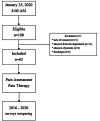Pain prevalence and pain management in children and adolescents in an italian third level pediatric hospital: a cross-sectional study
- PMID: 36978099
- PMCID: PMC10053721
- DOI: 10.1186/s13052-023-01439-2
Pain prevalence and pain management in children and adolescents in an italian third level pediatric hospital: a cross-sectional study
Abstract
Background: In 2016, we performed a one-day investigation to analyze the prevalence of pain, pain intensity, and pain therapy in the Departments of Surgery and Onco-Hematology of the Ospedale Pediatrico Bambino Gesù. To improve the knowledge gap highlighted in the previous study, refresher courses and even personalized audits have been carried out during these years. The purpose of this study is to evaluate if, after 5 years, there have been improvements in the management of pain.
Methods: The study was conducted on 25 January 2020. Pain assessment, pain therapies, pain prevalence and intensity in the preceding 24 h and during the recovery period were recorded. Pain outcomes were compared with previous audit results.
Results: Out of the 63 children with at least one documented pain assessment (starting from 100 eligible), 35 (55.4%) experienced pain: 32 children (50.7%) experienced moderate /severe pain while 3 patients (4%) felt mild pain. In the preceding 24 h, 20 patients (31.7%) reported moderate/severe pain while 10 (16%) reported moderate or severe pain during the interview. The average value of the Pain Management Index (PMI) was - 1.3 ± 0.9 with a minimum of -3 and a maximum of 0. 28 patients (87%) undergoing analgesic therapy for moderate/severe pain had a PMI of less than 0 (undertreated pain), while 3 patients (13%) scored value of 0 or higher (adequate pain therapy), 4 patients (12.5%) received multimodal analgesia with opioids and 2 patients (6%) opioids alone. Time-based therapy was prescribed to 20 patients (62.5%), intermittent therapy was prescribed to 7 patients (22%) and 5 patients (15.5%) did not receive any therapy. The prevalence of pain was higher during hospitalization and 24 h before the interview, while at the time of the interview, the proportion was the same. In this audit, the daily prescription modality of the therapy had some improvements (time-based: 62.5% vs. 44%; intermittent: 22%vs 25%; no therapy: 15.5% vs. 31%).
Conclusion: Pain management in hospitalized children constantly requires special daily attention from health professionals aimed at mitigating the components of intractable pain and resolving those of treatable pain.
Trial registration: This study is registered with ClinicalTrials.gov, number (NCT04209764), registered 24 December 2019, https://clinicaltrials.gov/ct2/show/NCT04209764?term=NCT04209764&draw=2&rank=1 .
Keywords: Analgesic score; Anesthesia; Cancer; Children; Opioid; Pain; Pain management; Pain management index; Pediatric pain.
© 2023. The Author(s).
Conflict of interest statement
The authors declare that they have no competing interests.
Figures
Similar articles
-
Prevalence of pain in the departments of surgery and oncohematology of a paediatric hospital that has joined the project "Towards pain free hospital".Clin Ter. 2016 Sep-Oct;167(5):156-160. doi: 10.7417/CT.2016.1948. Clin Ter. 2016. PMID: 27845483
-
Pain in hospitalized children: a prospective cross-sectional survey of pain prevalence, intensity, assessment and management in a Canadian pediatric teaching hospital.Pain Res Manag. 2008 Jan-Feb;13(1):25-32. doi: 10.1155/2008/478102. Pain Res Manag. 2008. PMID: 18301813 Free PMC article.
-
Pain and pain management in children and adolescents receiving hospital care: a cross-sectional study from Sweden.BMC Pediatr. 2022 May 5;22(1):252. doi: 10.1186/s12887-022-03319-w. BMC Pediatr. 2022. PMID: 35513880 Free PMC article.
-
Recent advances in pain treatment for children with serious illness.Pain Manag. 2019 Nov;9(6):583-596. doi: 10.2217/pmt-2019-0029. Epub 2019 Nov 18. Pain Manag. 2019. PMID: 31735116 Review.
-
[Pain therapy in emergency medicine. Focus on emergency admissions].Anaesthesist. 2013 Nov;62(11):902-8, 910-3. doi: 10.1007/s00101-013-2247-x. Anaesthesist. 2013. PMID: 24173544 Review. German.
Cited by
-
Development of a measure of knowledge and attitudes about obstructive sleep apnea for pediatric anesthesia (OSAKA-PedAn) and survey of knowledge and attitudes about pediatric obstructive sleep apnea among Italian anesthesiologists.J Anesth Analg Crit Care. 2025 Jul 1;5(1):39. doi: 10.1186/s44158-025-00260-z. J Anesth Analg Crit Care. 2025. PMID: 40598480 Free PMC article.
-
AI for chronic pain in children: a powerful resource.BMC Pediatr. 2025 May 30;25(1):433. doi: 10.1186/s12887-025-05796-1. BMC Pediatr. 2025. PMID: 40442702 Free PMC article.
-
Expert consensus on feasibility and application of automatic pain assessment in routine clinical use.J Anesth Analg Crit Care. 2025 Jun 2;5(1):29. doi: 10.1186/s44158-025-00249-8. J Anesth Analg Crit Care. 2025. PMID: 40457422 Free PMC article. Review.
-
Advances in pediatrics in 2023: choices in allergy, analgesia, cardiology, endocrinology, gastroenterology, genetics, global health, hematology, infectious diseases, neonatology, neurology, pulmonology.Ital J Pediatr. 2024 Nov 14;50(1):244. doi: 10.1186/s13052-024-01818-3. Ital J Pediatr. 2024. PMID: 39538247 Free PMC article. Review.
-
Predicting Post-surgery Discharge Time in Pediatric Patients Using Machine Learning.Transl Med UniSa. 2024 Jul 18;26(1):69-80. doi: 10.37825/2239-9747.1055. eCollection 2024. Transl Med UniSa. 2024. PMID: 40151426 Free PMC article.
References
-
- Joint Commission Statement on Pain Management. 04.2016.pdf [Internet]. [cited 2022 Nov 13]. Available from: https://www.healthcareinspirations.com/downloads/Joint%20Commission%20St...
Publication types
MeSH terms
Substances
Associated data
LinkOut - more resources
Full Text Sources
Medical
Miscellaneous



